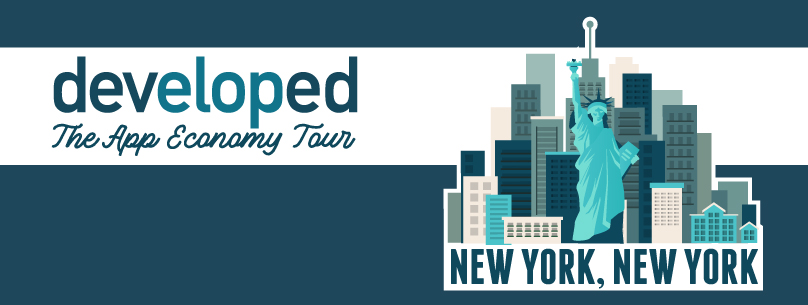On September 19, 2019, ACT | The App Association visited Our New York/Vodka, a New York City based distillery, to engage with developers about the local tech community, New York’s app economy, and general trends and opportunities for tech businesses. App Association member Kaia Health’s Marc Liber spoke at the event. Below, Marc discusses the role platforms play in Kaia Health’s overall business strategy and the ways Kaia Health utilizes the tools available on platforms for small businesses as they continue to innovate around digital therapeutics.
As far back as my rational mind recollects, I wanted to be a doctor. I wanted to devote myself to helping others; guiding people’s health seemed to me the most noble of career aims. Years later, the Affordable Care Act was top of mind on the national stage, and the healthcare system’s challenges for consumers were summarized over-simplistically by “access and affordability.” I saw that a career as a doctor could only allow me to touch those who could access and afford my services and those of my would-be peers.
As it happened, during this time smartphones and wearables were also coming to the forefront of the medical community, and computing power improved in these devices exponentially each year. Waves of digital innovation had begun to occur, and companies were building apps that could be instantly downloaded on platforms like Google Play or Apple’s App Store. Companies could seamlessly solve multiple stakeholders’ challenges and iterate swiftly to meet users’ needs. After watching this tech revolution begin to occur in healthcare, I jumped at the chance to join a Germany-based medtech company, Kaia Health, to play a foundational role in bringing Kaia to the U.S. market.
At Kaia, our grand aim is to be a trusted source of healthcare for Americans that leverages the best technology to make therapies accessible and cost-effective for all populations. To get there, we build medical-grade software intended to treat disease, otherwise known as “digital therapeutics.” Though Kaia’s product for chronic pain is delivered in a novel, high-tech way, its clinical foundation is far from new.
The backbone of Kaia is multimodal pain therapy (MMPT), which has been shown in medical literature to be the best-in-class therapy available for chronic pain. It is typically accessed today as an outpatient procedure, where the patient comes into the clinic daily for a period of weeks. MMPT has a high clinical evidence factor, but only a very small percentage of people who could benefit from it are able to access it. Why, you ask? It comes back to access and affordability – MMTP is often not covered by insurance, and with a price tag of $40,000+ for one course of therapy, few clinics in the United States offer MMPT.
At Kaia we feel that there is a large opportunity here to take the best of medical science and the best of technology, blend them together, and revolutionize the access to and cost-effectiveness of MMPT. Thanks to platforms, we’re able to deliver a digitized form of MMPT to the user’s device via our mobile application, instantly giving them access to MMPT and Kaia’s own accredited health coaches. Kaia’s form factor allows us to utilize data inputs from users and their devices to make their therapy experience personalized and adaptive to their clinical progress and skill level, and we can rapidly iterate on the product’s user experience. We’re able to deliver a unique “digital physical therapy” experience using our artificial intelligence-powered Motion Coach™.
The Motion Coach allows us to track users’ completion of their in-app physical exercises, count repetitions, and give real time feedback on users’ form for therapy safety and efficacy. Motion Coach facilitates effective and safe completion of our MMPT program, which is backed by some of the country’s leading healthcare delivery and insurance organizations.
In many ways, the current development environment has leveled the playing field for small software businesses. Online platforms allow companies of any size to gain early users and market share. Platforms also empowered the consumer, giving them more choices when it comes to apps, and developers in turn responded by creating apps for a wider audience. In Kaia’s case, when we’re building our software, we can’t just think about the end user as a well-off, healthy professional – it’s our responsibility to design an app for users of all abilities. We consciously design for the 70-year-old who is technically challenged and has several medical comorbidities, a visually-impaired person who may not be able to see their device screen, or a physically-handicapped individual who cannot physically perform the MMPT we offer.
Platforms have given app developers great power, but we know that with great power comes great responsibility. If we, as app developers, stay focused on building for “our average user,” our addressable market will shrink every day. Thousands of people turn 18 and 65 each day, and many who previously could not access our services, perhaps like some of my above-mentioned examples of Kaia users, are creating accounts. Development and distribution need to keep up, or we risk compromising our ability to enhance access and affordability for patients across all verticals. If it does not, it threatens our viability as businesses. What is more serious, in my view, is that if development and distribution do not keep up, we have a very real power to further the cultural, socioeconomic, and healthcare disparities that we sought to solve in the first place.
Mark is the VP of Business Development at Kaia Health.
